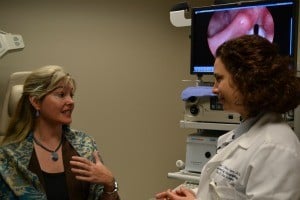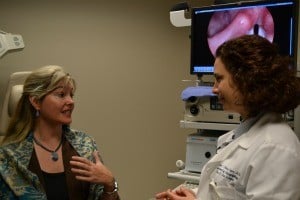The Muse Sings Again
| “In 20 years of singing, I’ve never had anything like this happen,” said Deleen Davidson, a lyric soprano, formerly with the New Orleans Opera.
Deleen, who now heads up The Muses Creative Artistry Project in Hot Springs, began to experience sinus and allergy problems in November, but within weeks her laugh changed, her speaking voice sounded like a squeak, and teaching choir students at the Arkansas School for Mathematics, Sciences and the Arts made her voice hoarse.
Faced with performing Pergolesi’s “Magnificat” in a winter concert, Deleen sought medical help and was given steroids. She made it through the strenuous performance but by Christmas Eve, she had no vocal strength.
“I couldn’t sing hymns without my middle voice fading out. It was frustrating and I had to cancel professional singing engagements, something else I’ve never had to do.”
Deleen was referred to Dr. Ozlem E. Tulunay-Ugur, Director of the Voice and Swallowing Center and an assistant professor in the Department of Otolaryngology – Head and Neck Surgery in the College of Medicine at UAMS.

Deleen Davidson performs “cup bubbles” breathing exercise for speech-language pathologist Hylan Pickett.
In February, Dr. Tulunay-Ugur performed a high-definition digital stroboscopy and diagnosed Deleen with a vocal cord hemorrhage and nodules, similar to what threatened Grammy Award-winning singer Adele’s future. A rigid endoscope with a tiny lens and light at the end is fed through the mouth and sits at the back of the tongue to look down onto the larynx, delivering a magnified view of the vocal cords.
Similar to attempting to watch a hummingbird hover, it’s impossible to examine high-speed vibrations of vocal cords with the naked eye. The strobe light illuminates the cords tightening, relaxing and vibrating while the patient is asked to hold a long “e” sound.
“It was shocking to see,” Deleen said about viewing the video images of the bleeding on her left vocal cord on the monitor. “It looked like one red polyp.”
Tiny lesions or cysts on the vocal cords affect how fast a vibration, or for a singer, a vibrato can last. As air is forced through the vocal cords, the slightest mound can affect other aspects of voice, too, such as sound and pitch.
Deleen, who had been taking Advil and antihistamines for allergies, was ordered to eliminate Advil which can cause bleeding and the drying allergy medication, which can adversely affect vocal cords. To combat dehydration, Dr. Tulunay-Ugur instructed her to drink lots of water and ordered one week’s complete vocal rest.
“When I came back a week later, I think they were actually surprised that I had not uttered a sound for one whole week,” said Deleen.
With just weeks to go before the first Muses concert of the year, Deleen saw “nodules and that the bleeding had resolved” during her second stroboscopy.

Deleen Davidson speaks with Ozlem Tulunay-Ugur, M.D., as an image of Davidson’s vocal cords is projected on the monitor.
“That’s when I began voice therapy sessions,” with Hylan Pickett, a certified speech-language pathologist and adjunct faculty in the Department of Audiology and Speech Pathology, a joint program with the University of Arkansas at Little Rock and the College of Health Related Professions at UAMS.
Hylan, whose undergraduate degree is in vocal music, is the only classically trained voice specialist at UAMS and is particularly suited to help patients like Deleen.
“Let’s transition into the ‘ooh’ and then we’ll do humming,” Hylan said. “I’m hearing great things – very vertical vowels.”
Voice therapy consists of exercises and education. In Deleen’s case, “re-education” was in order as Pickett began working to raise the pitch of Deleen’s speaking voice. Initial exercises included blowing bubbles in a cup four times a day and other breathing exercises with phrases like, “munch on mushy melons.”
“Okay, move into the glides. Think about starting it with the air, like a sigh almost. Being more mindful will give you some relief,” advised Hylan.
Deleen was making steady progress in voice therapy sessions and learning her music for “Printemps: French Art Song” by visualization, memorization and humming. Then with only eleven days until the Muses spring concert, Deleen underwent her third scope with Dr. Tulunay-Ugur. She hoped she would get the doctor’s approval to sing.
“You remember this, I’m sure.” Dr. Tulunay-Ugur said, holding a six-inch scope. She placed a microphone resembling a stethoscope around Deleen’s neck. Deleen’s voice would then activate the stroboscope.
“Say eeeeeeeee,” Dr. Tulunay-Ugur instructed, and up popped images of smooth, white and improved vocal cords.
Dr. Tulunay-Ugur smiled, nodded and pulled the scope from Deleen’s mouth.
With the help of doctors and specialists from UAMS, Deleen saved her voice and delighted Muse patrons at the spring concert. She looks forward to upcoming performances in Austria and Japan.
